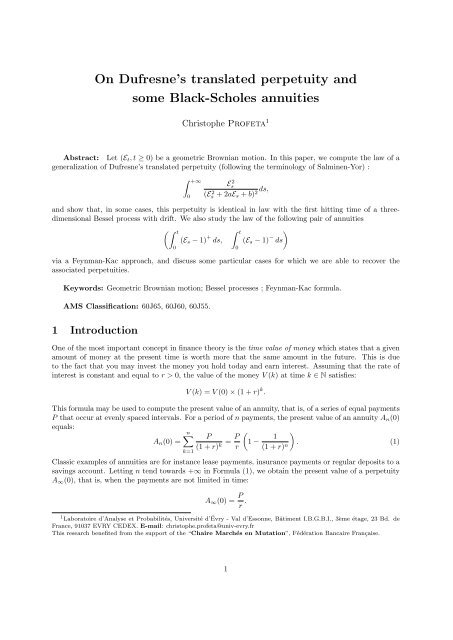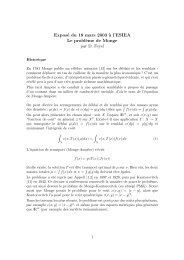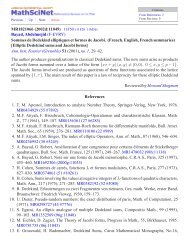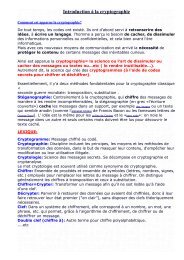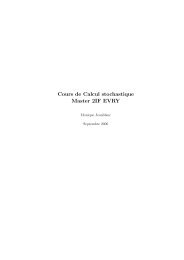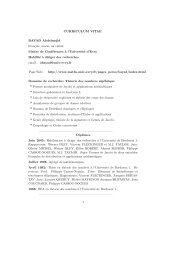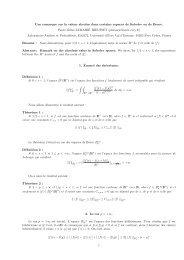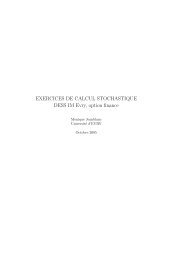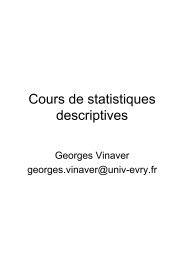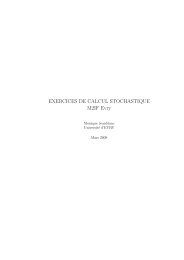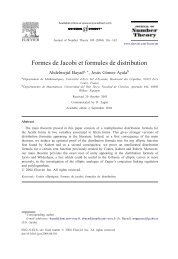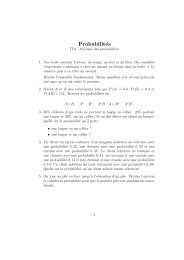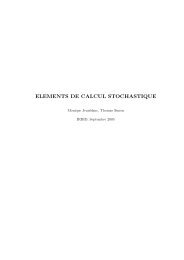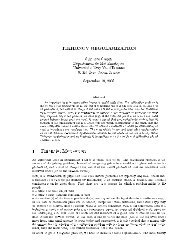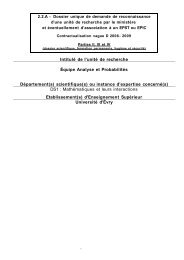On Dufresne's translated perpetuity and some Black-Scholes annuities
On Dufresne's translated perpetuity and some Black-Scholes annuities
On Dufresne's translated perpetuity and some Black-Scholes annuities
Create successful ePaper yourself
Turn your PDF publications into a flip-book with our unique Google optimized e-Paper software.
This is <strong>some</strong>what different from the price of a classic European Call option, where only the final value ofthe underlying asset at time T is considered (see [Cha12]) :[E (S T − K) +] .Of course, Asian options are harder to compute in practice as they depend on the entire past history of theunderlying asset, but they make it possible to reduce the risk of price manipulation near the maturity date.The paper is finally concluded by a short appendix on Bessel functions <strong>and</strong> Bessel processes (with drift).2 A generalization of Dufresne’s <strong>translated</strong> <strong>perpetuity</strong>In this section, we compute the law of the perpetuities :∫ +∞0Es2 ∫ +∞(Es 2 + 2aE s + b) 2 ds <strong>and</strong> M 2 s(M 2 s + 2aM s + b) 2 ds.0Theorem 2. Assume that the polynomial z 2 + 2az + b does not have positive roots. For 2λ + a 2 − b ≥ 0,we have:( ∫ √2λ x)dz( ∫ +∞EsE x[exp2 )] √ sinh + a2 − b−λ0 (Es 2 + 2aE s + b) 2 ds x2 + 2ax + b0 z=2 + 2az + b( ∫x√2λ +∞)dzsinh + a2 − bz 2 + 2az + b<strong>and</strong>( ∫ +∞ME x[exp2 )] √ sinhsb + 2ax + x−λ0 (M 2 s + 2aM s + b) 2 ds 2= √b( ∫ √2λ b/x+ a2 − bsinh( √2λ+ a2 − b00∫ +∞0)dzz 2 + 2az + b).dzz 2 + 2az + bThe equality in law given in Theorem 1 follows directly from this result, since when a 2 − b ≥ 0, onerecognizes in the right-h<strong>and</strong> side the expression of the Laplace transform of the first passage time of athree-dimensional Bessel process with drift √ a 2 − b. A short review of Bessel processes with drift is givenin Section 5, where these Laplace transforms are also inverted thanks to Jacobi’s theta function.2.1 A martingale approach to Dufresne’s <strong>translated</strong> <strong>perpetuity</strong>Let x > 0 <strong>and</strong> assume that E 0 = x. By Lamperti’s relation (see Theorem 7), there exists a threedimensionalBessel process (R t , t ≥ 0) started from x such that:E t = R At with A t = 〈E〉 t =Using this transform <strong>and</strong> the change of variable u = A s , we obtain :∫ +∞0Es2 ∫ +∞(Es 2 + 2aE s + b) 2 ds =0∫ t0(E s ) 2 ds.R 2 A s(R 2 A s+ 2aR As + b) 2 ds = ∫ +∞01(Ru 2 du. (2)+ 2aR u + b)2To compute the law of this <strong>perpetuity</strong>, we shall construct the appropriate martingale, thanks to thefollowing lemma:4
Lemma 3 ([PZ03]). Let ∆ = a 2 − b <strong>and</strong> 2λ + ∆ > 0. Set for x ≥ 0:Then, the functionsη(x) =are two independent solutions of the equation:∫ x0dzz 2 + 2az + b .φ ± (x) = √ (x 2 + 2ax + b exp ±η(x) √ )2λ + ∆f ′′ −2λ(x 2 + 2ax + b) 2 f = 0.Let (W t , t ≥ 0) be a Brownian motion. Applying Itô’s formula, we deduce that the process√(M t = Wt 2 + 2aW t + b sinh η(W t ) √ () ∫ )tdu2λ + ∆ exp −λ(Wu 2 + 2aW u + b) 2is a continuous martingale, <strong>and</strong> with T 0 = inf{t ≥ 0, W t = 0}, Doob’s optional stopping theorem implies:√x2 + 2ax + b sinh( √2λ+ ∆η(x))[ √ (= E x Wt∧T 2 0+ 2aW t∧T0 + b sinh η(W t∧T0 ) √ () ∫ t∧T02λ + ∆ exp −λ[ √ (= E x Wt 2 + 2aW t + b sinh η(W t ) √ () ∫ t2λ + ∆ exp −λ000)]du(Wu 2 + 2aW u + b) 2)du(Wu 2 + 2aW u + b) 2 1 {t
after the change of variable y = xz.=√b + 2ax + x2√b( ∫ )√2λb/xdysinh + ∆0 y 2 + 2ay + b( ∫ √2λ +∞).dysinh + ∆y 2 + 2ay + b0Remark 4. Letting x tend towards 0 in (3), we obtain the simple formula:[ ( ∫ )]+∞√E (3)du2λ + ∆0 exp −λ(Ru 2 + 2aR u + b) 2 = √ ( √ ).b sinh η(+∞) 2λ + ∆02.2 A probabilistic approach to Dufresne’s <strong>translated</strong> <strong>perpetuity</strong>We now give another proof of Theorem 2, with a slightly more probabilistic approach. Let x > 0 <strong>and</strong>assume that M 0 = x. From the Dambis, Dubins-Schwarz theorem (see [RY99, Theorem 1.6, p.181]), thereexists a Brownian motion (B t , t ≥ 0) started from x such that:Therefore:∫ +∞0M 2 ∫ +∞s(M 2 s + 2aM s + b) 2 ds =M t = B 〈M〉t with 〈M〉 t =0∫ t0(M s ) 2 ds.B 2 〈M〉 s(B 2 〈M〉 s+ 2aB 〈M〉s + b) 2 ds = ∫ T001(Bu 2 du, (5)+ 2aB u + b)2where T 0 = inf{u ≥ 0, B u = 0}. By the classic time-reversal result of Brownian motion (see Section 5),this last expression is seen to be identical in law with:∫ T001(B 2 u + 2aB u + b) 2 du = ∫ T00∫1Gx(law)(BT 2 + 2aB ds =0−s T 0−s + b)201(Rs 2 ds (6)+ 2aR s + b)2where (R s , s ≥ 0) is a three-dimensional Bessel process starting from 0 <strong>and</strong> G x = sup{s ≥ 0, R s = x}.To compute the law of this last expression, we shall first consider the whole <strong>perpetuity</strong>∫ +∞0ds(R 2 s + 2aR s + b) 2 .From the occupation time formula <strong>and</strong> Ray-Knight’s third theorem (see Theorem 10):∫ +∞0∫ds+∞(Rs 2 + 2aR s + b) 2 =0L y ∞(R)(y 2 + 2ay + b)(law)2dy =∫ +∞0Z (2)y(y 2 + 2ay + b) 2 dywhere (Z y(2) , y ≥ 0) denotes a two-dimensional squared Bessel process starting from 0. Then, from Theorem8, the Laplace transform of the right-h<strong>and</strong> side equals :[ ( ∫ )]+∞Z y(2)E exp −λ(y 2 + ay + b) 2 dy = F (∞)where F is the unique solution on [0, +∞[ of :F ′′ =02λ(x 2 F such that F is positive, non increasing, <strong>and</strong> F (0) = 1.+ 2ax + b)26
Therefore, from Lemma 3, there exist two constants α <strong>and</strong> β such that :F (x) = √ ( (x 2 + 2ax + b α cosh η(x) √ ) (2λ + ∆ + β sinh η(x) √ ))2λ + ∆ .Since F (0) = 1, we deduce that:α = 1 √b.Next, as F is positive <strong>and</strong> non increasing, the limit F (∞) necessarily exists, so we must have :which yields1(√ cosh η(+∞) √ ) (2λ + ∆ + β sinh η(+∞) √ )2λ + ∆ = 0bβ = − 1 √bcosh ( η(+∞) √ 2λ + ∆ )sinh ( η(+∞) √ 2λ + ∆ ) .Finally, thanks to the additivity formula of sinh:√x2 + 2ax + b sinh (√ 2λ + ∆(η(∞) − η(x)) )√2λ + ∆F (x) = √b sinh ( η(+∞) √ 2λ + ∆ ) −−−−−→ √ ( √ )x→+∞ b sinh η(+∞) 2λ + ∆<strong>and</strong> we recover the result of Remark 4. Now, to obtain the result for any x > 0 we shall use a decompositionof the paths of the three-dimensional Bessel process at its last passage time G x = sup{t ≥ 0, R t = x}.From Theorem 9, we may write :∫ +∞0∫dsGx(Rs 2 + 2aR s + b) 2 ==(law)=0∫ Gx0∫ Gx0∫ds+∞(Rs 2 + 2aR s + b) 2 +G x∫ds+∞(Rs 2 + 2aR s + b) 2 +∫ds+∞(Rs 2 + 2aR s + b) 2 +00ds(R 2 s + 2aR s + b) 2ds(R2Gx+s + 2aR G x+s + b ) 2ds((x + ˜R s ) 2 + 2a(x + ˜R s ) + b(where ˜Rs , s ≥ 0)is an independent copy of (R s , s ≥ 0). Taking the Laplace transform of both sides, weobtain, from (5) <strong>and</strong> (6):[ (E (3)0= E (3)0exp[exp−λ(∫ +∞0−λ∫ Gx( ∫ +∞= E x[exp −λ0which yields the formula:0)]ds(Rs 2 + 2aR s + b) 2)]ds(Rs 2 + 2aR s + b) 2E (3)0⎡⎛⎢ ⎜⎣exp ⎝−λ∫ +∞M 2 )] [ ( ∫ +∞s(M 2 s + 2aM s + b) 2 ds E (3)0 exp −λ0( ∫ +∞ME x[exp2 )]s−λ0 (M 2 s + 2aM s + b) 2 ds0) 2⎞⎤⎟⎥) 2 ⎠⎦ds((x + ˜R s ) 2 + 2a(x + ˜R s ) + b)]ds(Rs 2 + (2a + 2x)R s + x 2 + 2ax + b) 2 ,7
( ∫ √2λ +∞)dz√ sinh + a2 − bx2 + 2ax + b0 z= √ 2 + 2(a + x)z + x 2 + 2ax + b( ∫ b√2λ +∞) .dzsinh + a2 − bz 2 + 2az + bThis new expression is seen to agree with Theorem 2 by applying the change of variable z = b y− x in theintegral on the numerator. The other relation follows as before thanks to (4).02.3 A few particular casesi) When a = 1 <strong>and</strong> b = 1, we recover a particular case of Hariya’s identity :∫ +∞with E 0 = x <strong>and</strong> R 0 = 1 − 11+x .00Es2 ∫ +∞(Es 2 + 2E s + 1) 2 ds = ds (law)(R s + 1) 4 = inf {t ≥ 0, R t = 1} .ii) More generally, when a = √ b,∫ +∞Es2 ∫ +∞{(Es 2 + 2bE s + b 2 ) 2 ds = ds (law)(R s + b) 4 = inf t ≥ 0, R t = 1 },bwith E 0 = x <strong>and</strong> R 0 = 1 b − 1x+b .00iii) We may recover the result of Salminen-Yor [SY05] by letting b → 0. Indeed, for 0 < b < a 2 , we have:∫ ( (xdzz 2 + 2az + b = 12 √ x + a − √ ) (aln2 − ba 2 − b x + a + √ a − √ ))a− ln2 − ba 2 − b a + √ a 2 − b0so that, letting b go towards 0, we obtain:( √2λ ∫ xsinh + a2 − b0<strong>and</strong>)dzz 2 + 2az + b∼b→0⎛ ⎛√ ( )12 exp ⎝ 2λ + a2 x⎝ln2a x + 2a( ∫ +∞)] √ ( )dsE x[exp√ 2λ+a 2x + 2a x2a−λ0 (E s + 2a) 2 = √ x x + 2a=⎛ √ ⎞⎞⎞− ln ⎝ 1 − 1 − ba 2⎠⎠⎠2( ) √ 2λ+a 2x2a − 1 2.x + 2aThis last expression is seen to coincide with the Laplace transform of the first hitting time at level12a ln ( )x+2ax of a Brownian motion with drift a started from 0, which was the announced result inthe introduction, with x = 1.We refer to Salminen & Yor [SY04, SY05] <strong>and</strong> Decamps, De Schepper, Goovaerts & Schoutens [DDSGS05]for similar articles on this subject.3 Some <strong>Black</strong>-<strong>Scholes</strong> <strong>annuities</strong>Let (B t + νt, t ≥ 0) be a st<strong>and</strong>ard Brownian motion with drift ν started from 0. In this section, we studythe law of the pair of <strong>annuities</strong> :(∫ t () +∫ t () ) −e 2β(Bs+νs) − 1 ds, e 2b(Bs+νs) − 1 ds (7)where x + = max(0, x) <strong>and</strong> x − = min(0, x).008
Theorem 5. Let α, β, a, b, λ ≥ 0 <strong>and</strong> ν ∈ R. The double Laplace transform of the couple (7) is given by:∫ +∞0(e −(λ+a)t E 0[exp −α( (√= 22αK 2γω λ βwhere the Wronskien ω λ equals:∫ t0) ∫ 0ω λ = √ 2aK 2γ(√2αβ() +∫ te 2β(Bs+νs) − 1 ds − a(√ ) (√2a2ae νy I 2c−∞ b eby dy + I 2cb)I ′ 2c0() )] −e 2b(Bs+νs) − 1 ds dt) ∫ +∞(√ )2a− √ (√ ) (√ )2α 2a2αK 2γ′ I 2cbβ b<strong>and</strong> I 2c <strong>and</strong> K 2γ denote the third modified Bessel functions with respective indexes0e νy K 2γ(√2αβ eβy )dy⎧1 √2(λ + a) − 2α + ν2if 2(λ + a) − 2α + νc =2b√ 1 ⎪⎨2 ≥ 02β2λ + ν2<strong>and</strong> γ =⎪⎩i √2α − 2(λ + a) − ν2otherwise.2βThe proof of this result is given in the next Sections 3.1 <strong>and</strong> 3.2. We will discuss in Section 4 <strong>some</strong> specialcases for which the expression on the right-h<strong>and</strong> side simplifies.3.1 A useful version of the Feynman-Kac formulaTo prove Theorem 5, we shall apply the following well-known Feynman-Kac formula, see for instanceJanson [Jan07, Appendix C] where many other Brownian areas are also studied.Theorem 6 (Feynman-Kac). Let V (x) ≥ 0 be a positive continuous function on R, λ > 0, <strong>and</strong> let φ +<strong>and</strong> φ − be two C 2 -solutions of the differential equation)such that, for A large enough :12 φ′′ (x) = (V (x) + λ)φ(x) (8)φ + is positive <strong>and</strong> bounded on [A, +∞[ <strong>and</strong> φ − is positive <strong>and</strong> bounded on ] − ∞, −A]. (9)Let w λ := φ + (0)φ ′ −(0) − φ − (0)φ ′ +(0) <strong>and</strong> assume that ω λ ≠ 0. Then, for any positive <strong>and</strong> measurablefunction f on R <strong>and</strong> any x ∈ R:∫ +∞ [e −λt E x e − ∫ ]t0 V (Bs)ds f(B t ) dt = 2 ( ∫ x∫ +∞)φ + (x) φ − (y)f(y)dy + φ − (x) φ + (y)f(y)dy .0ω λ −∞x(10)Proof.We sketch the proof of this result for the sake of completeness. First, define the Wronskien:W λ (x) = φ + (x)φ ′ −(x) − φ − (x)φ ′ +(x).Since φ + <strong>and</strong> φ − are solutions of (8), we deduce that Wλ ′ (x) = 0, hence for any x ∈ R, W λ(x) = W λ (0) =ω λ . Assume first that f is continuous <strong>and</strong> has compact support, <strong>and</strong> define:∫ x∫ +∞φ(x) = φ + (x) φ − (y)f(y)dy + φ − (x) φ + (y)f(y)dy.−∞x9
φ is a function of C 1 -class, <strong>and</strong> differentiation yields:φ ′ (x) = φ ′ +(x)∫ x−∞We thus deduce that φ is of C 2 -class, <strong>and</strong> from (8):φ − (y)f(y)dy + φ ′ −(x)∫ +∞xφ + (y)f(y)dy.φ ′′ (x) = 2(V (x) + λ)φ(x) − W λ (x)f(x) = 2(V (x) + λ)φ(x) − ω λ f(x).Observe also that, since f is a function with compact support, the function φ is bounded on R. Considernow the processM t = e −λt−∫ t0 V (Bs)ds φ(B t ) + ω λ2∫ t0e −λu−∫ u0 V (Bs)ds f(B u )du.From Itô’s formula, this process is a local martingale <strong>and</strong> we have the estimate:|M t | ≤ sup |φ(x)| + ω λx∈R 2 sup |f(x)|x∈R∫ t0e −λu du ≤ sup |φ(x)| + ω λx∈R 2λ sup |f(x)|.x∈RTherefore M is uniformly bounded, i.e. M is a bounded martingale <strong>and</strong>φ(x) = E x [M 0 ] = E x [M ∞ ] = ω [∫ +∞]λ2 E x e −λu−∫ u0 V (Bs)ds f(B u )du .By a monotone class argument, the assumption on the continuity of f may be dropped, so Relation (10)is in fact valid for any positive <strong>and</strong> measurable function with compact support. Let now f by a positive<strong>and</strong> measurable function, <strong>and</strong> consider the sequence of functionsf n (y) = f(y)1 {|y|≤n} .Since the f n have compact support, we may apply Relation (10) <strong>and</strong> write, for n large enough:∫ +∞ [e −λt E x e − ∫ ]t0 V (Bs)ds f(B t )1 {|Bt|≤n} dt = 2 ( ∫ x∫ n)φ + (x) φ − (y)f(y)dy + φ − (x) φ + (y)f(y)dy .0ω λ −nxWe finally end the proof by letting n → +∞ <strong>and</strong> applying the monotone convergence theorem thanks tothe Condition (9).03.2 Proof of Theorem 5We restrict our attention to the case x = 0, for which the formulae take a simpler form. To prove Theorem5, we first remove the drift thanks to the Cameron-Martin formula, which states that for every functionalF :[]E 0 [F (B s + νs, s ≤ t)] = E 0 e νBt− ν2 t2 F (Bs , s ≤ t) = e − ν2 t [2 E0 eνB tF (B s , s ≤ t) ] .Therefore the double Laplace transform reads:∫ +∞( ∫ t (e −(λ+a)t E 0[exp −α e 2β(Bs+νs) − 10∫ +∞=0ν2 −(λ+e 2 )t E 0[e νBt exp0(−α∫ tConsider the ordinary differential equation:12 φ′′ (x) =0) +ds − a∫ t(e 2β(Bs+νs) − 10() )] −e 2b(Bs+νs) − 1 ds dt) +ds − at − a∫ t(α(e 2βx − 1)1 {x>0} + a(e 2bx − 1)1 {x
The function V defined byV (x) = α(e 2βx − 1)1 {x>0} + a(e 2bx − 1)1 {x
where the Wronskien ω λ equals:ω λ = √ 2λ + ν 2 K 2γ(√2αβ)− √ (√ )2α2αK 2γ′ .βWe may also recover the Laplace transform of the associated <strong>perpetuity</strong> as follows. Assume that ν < 0<strong>and</strong> replace λ by λε to obtain:∫ +∞0e −λεt E 0[e −α ∫ t0 (e 2β(Bs+νs) −1) + ds ] dt = 1 εNow letting ε → 0, we deduce that:1λ E 0[e −α ∫ +∞0 (e 2β(Bs+νs) −1) ] ⎛+ ds 2ε= lim ⎝ε→0 w λε= 2|ν|λ∫ +∞0∫ +∞0e −λt E 0[e −α ∫ t/ε0 (e 2β(Bs+νs) −1) + ds ] dt.e νy K 2γ(√2αβ eβy )dy +( √2α )K 2γ β( √2α )|ν|K 2γ − √ ( √2α ),2αK 2γ ′ββ( √2α ) ⎞K 2γ βν + √ ⎠2λε + ν 2which agrees with [PRY10, Section 4.4, p.107]. Unfortunately, it does not seem easy to invert this Laplacetransform.4.2 The positive sojourn time of Brownian motion with driftLet first α → 0. From the asymptotics (see Section 5.1):we deduce that∫ +∞02 ν−1 Γ(ν)K ν (z) ∼z→0 z ν <strong>and</strong> zK ν(z) ′ ν2 ν−1 Γ(ν)= −zK ν−1 (z) − νI ν (z) ∼z→0 z ν[e −λt E 0 e −at−a ∫ t0 (e 2b(Bs+νs) −1) ] ⎛− dsdt = 2 ∫ 0(√ )⎝2ae νy I 2γω λ −∞ b eby dy +where the Wronskien ω λ equals:ω λ = √ 2aI ′ 2c(√ )2aWe now let further b → +∞. The left-h<strong>and</strong> side yields :t +∫ t0() −∫ te 2b(Bs+νs) − 1 ds = t +b−−−−→b→+∞+ √ (√ )2a2(λ + a) + ν 2 I 2c .be 2b(Bs+νs) 1 {Bs+νs
<strong>and</strong>I ′ √2λ+ν 2b(√ )2ab= I √ 2λ+ν 2b +1(√ )2a+b√2λ + ν2√2aI √ 2λ+ν 2b(√ )2ab−−−−→b→+∞√2λ + ν2√2a.Therefore, we deduce that∫ +∞0e −λt E 0[e −a ∫ t0 1 {Bs+νs>0}ds ] dt = 2ω λ( ∫ 0−∞e νy e y√ 2λ+ν 2 dy +)1√2(λ + a) + ν2 − ν)(= 2 1ω λ ν + √ 2λ + ν + 1√ 2 2(λ + a) + ν2 − ν,withWe now study two further simplifications :i) When ν = 0, this expression simplifies to:∫ +∞0ω λ = √ 2λ + ν 2 + √ 2(λ + a) + ν 2 .0[e −λt E 0 e −a ∫ ] t0 1 1{Bs>0}dsdt = √ √λ λ + a<strong>and</strong> this double Laplace transform may be inverted to recover the celebrated Arcsine law of Brownianmotion:(∫ t)1P 0 1 {Bs>0}ds ∈ dz =π √ z √ t − z 1 {00}ds ∈ dz = |ν|√ 2 1√ √ e − ν22 z − |ν| √ 2π z4.3 Yor’s functional0Take a = α <strong>and</strong> b = β. Then, from (11), the Wronskien simplifies to<strong>and</strong> from the formula (see [GR07, p.712]) :we obtain the expression :∫ +∞02I γ (x)K γ (y) =∫ +∞0ω λ = βe − t 2 − x2 +y 22te −λt E 0[e −α ∫ t0 e2β(Bs+νs) ds ] dtI γ( xyt∫ +∞|ν| √ z√2e −t2 dt) dt, for y ≥ x,t)1 {z>0} dz.13
= 1 β= 1 β∫ +∞0∫ +∞0dtt exp (− t 2 − αdzz e−αz exp(exp − α)tβ∫R2(− 1 )2zβ∫R2 exp) ( ) 2αetβ 2 e2βy e νy βyI 2γtβ 2 dy(− 1 ) ( ) e2zβ 2 e2βy e νy βyI 2γzβ 2 dy.We may therefore invert the Laplace transform in α to obtain:(∫ τλ)P 0 e 2β(Bs+νs) ds ∈ dz = λ ∫ (10zβ e− 2zβ 2 exp − 1 )( ) eR 2zβ 2 e2βy e νy βyI √ 2λ+ν 2β zβ 2 dywhere τ λ denotes an exponential r<strong>and</strong>om variable with parameter λ independent from B.Note that this last Laplace transform may be also inverted thanks to the Hartman-Watson function θ rgiven by:∫ +∞I √ 2λ (r) = e −λt θ r (t)dtwhich, from Yor [Yor80], admits the representation:θ r (t) =r √2π3 t∫ +∞4.4 <strong>On</strong>e-sided Yor’s functionalTake a = α <strong>and</strong> let b → +∞. We obtain :∫ +∞0[e −λt E 0 e −α ∫ ] ⎛t0 e2β(Bs+νs) 1 {Bs+νs>0} dsdt = 2 ⎝ K 2γω λ00(e π2 −y 22t −r πy)cosh(y) sinh(y) sin dy.t( √2α)∫ +∞βν + √ 2λ + ν + 20(√ ) ⎞2αe νy K 2γβeβy ⎠with(√ )2α √2λω λ = K 2γ + ν2 − √ 2αK 2γ′ β(√ )2α.βThis allows to recover the associated <strong>perpetuity</strong>, for ν < 0 :(E 0[exp −α∫ +∞0)]e 2β(Bs+νs) 1 {Bs+νs>0}ds =2|ν|K |ν|β( √2αβ)√ ( √2α2αK |ν|β +1 βWe refer to Salminen & Yor [SY04, SY05] for a comprehensive study of this family of perpetuities.5 Appendix on Bessel functions <strong>and</strong> Bessel processes (with drift)5.1 Modified Bessel functions [Leb72, Chapter 5]For ν ∈ C, let I ν denote the modified Bessel function defined by:).I ν (x) =∞∑k=0(x/2) ν+2kΓ(k + 1)Γ(k + ν + 1)x > 0,<strong>and</strong> K ν the McDonald function defined, for ν /∈ Z, by:K ν (x) = π 2I −ν (x) − I ν (x)sin(νπ)x > 0,14
<strong>and</strong> for ν = n ∈ Z by :K n (x) = lim K ν (x).It is known that these functions generate the set of solutions of the linear differential equation:u ′′ + 1 )x u′ −(1 + ν2x 2 u = 0.ν→nν≠nTheir derivatives are seen to satisfy several recurrence relations:⎧⎪⎨ xI ν(x) ′ = xI ν−1 (x) − νI ν (x) = xI ν+1 (x) + νI ν (x),⎪⎩xK ν(x) ′ = −xK ν−1 (x) − νK ν (x) = −xK ν+1 (x) + νK ν (x),<strong>and</strong> their Wronskien takes a particularly simple form:W (I ν (x), K ν (x)) := I ν (x)K ′ ν(x) − I ′ ν(x)K ν (x) = − 1 x . (11)Note that they both simplify when ν = ±1/2:√ √22I −1/2 (z) =πz cosh(z), I 1/2(z) =πz sinh(z)<strong>and</strong>K −1/2 (z) = K 1/2 (z) =√ π2z e−z .For real <strong>and</strong> strictly positive ν > 0, I ν is a positive increasing function <strong>and</strong> K ν is a positive decreasingfunction. In this case, they both admit <strong>some</strong> useful integral representation:⎧x ν ∫ πI ν (x) =⎪⎨ 2 ν√ π Γ(ν + 1 2 ) e x cos(θ) sin 2ν (θ)dθ0⎪⎩ K ν (x) = 1 ( x) ν∫ +∞( )12 2 t ν+1 exp −t − x2dt4tfrom which we may deduce the following equivalents (still for ν > 0):0x νI ν (x) ∼x→0 2 ν Γ(ν + 1)<strong>and</strong> the asymptotic formulae when x → +∞:<strong>and</strong>K ν (x) ∼x→02 ν−1 Γ(ν)x ν ,I ν (x)∼x→+∞5.2 Bessel processes with drift [PY81]√e xπ√ <strong>and</strong> K ν (x) ∼2πx x→+∞ 2x e−x .Let δ ∈ N\{0} <strong>and</strong> c > 0. The Bessel process of dimension δ (or equivalently of index ν = δ 2− 1) <strong>and</strong> driftc is the diffusion (R (δ,c)t , t ≥ 0) with generator:G = 1 ∂ 2 ( 2ν + 12 ∂x 2 + + c I )ν+1 ∂(cx)2x I ν ∂x . (12)15
We denote by P (δ,c)x its law when started from x. This process may be obtained as the euclidean norm ofa δ-dimensional Brownian motion −→ B with drift −→ µ ∈ R δ such that ‖ −→ µ ‖ = c:R (δ,c)t= ‖ −→ B t + −→ µ −→ t ‖.The law of the first passage times of (R t , t ≥ 0) is given by the following Laplace transform:E (δ,c)xI ν (x⎧⎪ √ 2λ + c 2 )[e−λT a] ⎨ I ν (a √ I ν (ca)2λ + c 2 ) I ν (cx)=⎪ ⎩K ν (x √ 2λ + c 2 )K ν (a √ I ν (ca)2λ + c 2 ) I ν (cx)In particular, when δ = 3, (i.e. ν = 1 2), these formulae simplify to:E (3,c)xsinh(x⎧⎪ √ 2λ + c 2 )[e−λT a] ⎨ sinh(a √ sinh(ca)2λ + c 2 ) sinh(cx)=⎪ ⎩(exp −(x − a) √ ) sinh(ca)2λ + c 2 sinh(cx)Note that this Laplace transform may be inverted, see [EMOT54, p.258]:P (3,c)x (T a ∈ dt)/dt =⎧sinh(ca) 1√sinh(cx) 2πt3⎪⎨sinh(ca)⎪⎩sinh(cx)5.3 Bessel processes+∞∑n=−∞((2n + 1)a − x) exp()(x − a)√ exp (x − a)2− − c22πt3 2t 2 t(−if x ≤ a,if x ≥ a.if x ≤ a,if x ≥ a.((2n + 1)a − x)22t− c2 2 t )Letting c → 0 informally in (12), we obtain the generator of the classic Bessel process with index ν:if x ≤ a,if x ≥ a.G = 1 2 ∂x 2 + 2ν + 1 ∂2x ∂x . (13)These processes are deeply related with geometric Brownian motion thanks to the following Lamperti’srelation:∂ 2Theorem 7 ([Wil74]). Let (B t + νt, t ≥ 0) be a Brownian motion with drift ν > 0 starting from log(x).Then, there exists (R (ν)t , t ≥ 0) a Bessel process of index ν started from x such that:exp(B t + νt) = R (ν) ∫ t0 exp(2(Bs+νs))ds.In particular, for ν > 0, (R (ν)t , t ≥ 0) is transient <strong>and</strong> limt→+∞ R(ν) t = +∞ a.s. In the framework ofperpetuities, we may mention the following theorem, which allows to compute the law of <strong>some</strong> perpetuitiesinvolving squared Bessel processes, see [RY99, Theorem 1.7 p.444]:Theorem 8. Let ϕ be a positive <strong>and</strong> measurable function such that ∫ +∞(1 + x)ϕ(x)dx < +∞. Then:0[ ( ∫ +∞)]( x)exp − Rt 2 ϕ(t)dt = F (+∞) δ/2 exp2 F ′ (0)E (δ)xwhere F is the unique solution on [0, +∞[ of :0F ′′ = ϕ(x)F such that F is positive, non increasing, <strong>and</strong> F (0) = 1.16
5.4 The three-dimensional Bessel process [RY99, Chapter VI.3]We now take δ = 3 (i.e. ν = 1 2) in (13) to obtain the classic three-dimensional Bessel process. This processenjoys many important properties <strong>and</strong> is, in <strong>some</strong> sense, very close de Brownian motion. In particular,there is a weak absolute continuity formula between Brownian motion <strong>and</strong> the three-dimensional Besselprocess :P (3)x|F t= B tx 1 {t>T 0} P x|Ft . (14)The paths of a three-dimensional Bessel process admit a useful decomposition as follows:Theorem 9. Let (R t , t ≥ 0) be a three-dimensional Bessel process started from 0 <strong>and</strong> define G x = sup{t ≥0, R t = x} it last passage time at level x. Then:i) conditionally on G x , the processes (R t , t ≤ G x ) <strong>and</strong> (R t+Gx , t ≥ 0) are independent,ii) the process (R t+Gx , t ≥ 0) has the same law as (x + R t , t ≥ 0),iii) the process (R t , t ≤ G x ) has the same law as (B T0−t, t ≤ T 0 ) where (B t , t ≥ 0) is a Brownian motionstarted from x <strong>and</strong> T 0 = inf{t ≥ 0, B t = 0}.This result was first proven by Williams [Wil74] in its decomposition of the Brownian paths, see alsoPitman [Pit75] for a related study.We conclude this appendix by stating the third Ray-Knight theorem, which describes the dependence inthe space variable of the total local time of the three-dimensional Bessel process :Theorem 10 (Ray-Knight). Let (R t , t ≥ 0) be a three-dimensional Bessel process started from 0 <strong>and</strong>denote by L y ∞(R) its total local time at level y. Then:(L y ∞, y ≥ 0) (law)= (Z (2)y , y ≥ 0)where Z (2) is a two-dimensional squared Bessel process started from 0.We refer to [BS02, Chapter V] for other similar Ray-Knight theorems.References[AS92][BS02]M. Abramowitz <strong>and</strong> I. A. Stegun, editors. H<strong>and</strong>book of mathematical functions with formulas,graphs, <strong>and</strong> mathematical tables. Dover Publications Inc., New York, 1992. Reprint of the1972 edition.A. N. Borodin <strong>and</strong> P. Salminen. H<strong>and</strong>book of Brownian motion—facts <strong>and</strong> formulae. Probability<strong>and</strong> its Applications. Birkhäuser Verlag, Basel, second edition, 2002.[Cha12] D. Chamorro. Algunas herramientas matemáticas para la economía y las finanzas: elmovimiento Browniano y la integral de Wiener. Analítika, 3:3–15, 2012.[DDSGS05] M. Decamps, A. De Schepper, M. Goovaerts, <strong>and</strong> W. Schoutens.perpetuities. Sc<strong>and</strong>. Actuar. J., (4):261–270, 2005.A note on <strong>some</strong> new[Duf90][EMOT54]D. Dufresne. The distribution of a <strong>perpetuity</strong>, with applications to risk theory <strong>and</strong> pensionfunding. Sc<strong>and</strong>. Actuar. J., (1-2):39–79, 1990.A. Erdélyi, W. Magnus, F. Oberhettinger, <strong>and</strong> F. G. Tricomi. Tables of integral transforms.Vol. I. McGraw-Hill Book Company, Inc., New York-Toronto-London, 1954. Based, in part,on notes left by Harry Bateman.17
[GR07]I. S. Gradshteyn <strong>and</strong> I. M. Ryzhik. Table of integrals, series, <strong>and</strong> products. Elsevier/AcademicPress, Amsterdam, seventh edition, 2007. Translated from the Russian, Translation edited<strong>and</strong> with a preface by Alan Jeffrey <strong>and</strong> Daniel Zwillinger, With one CD-ROM (Windows,Macintosh <strong>and</strong> UNIX).[GY93] H. Geman <strong>and</strong> M. Yor. Bessel processes, Asian options <strong>and</strong> perpetuities. Mathematicalfinance, 3(4):349–375, 1993.[Jan07][Leb72][Pit75]S. Janson. Brownian excursion area, Wright’s constants in graph enumeration, <strong>and</strong> otherBrownian areas. Probab. Surv., 4:80–145, 2007.N. N. Lebedev. Special functions <strong>and</strong> their applications. Dover Publications Inc., New York,1972. Revised edition, <strong>translated</strong> from the Russian <strong>and</strong> edited by Richard A. Silverman,Unabridged <strong>and</strong> corrected republication.J. W. Pitman. <strong>On</strong>e-dimensional Brownian motion <strong>and</strong> the three-dimensional Bessel process.Advances in Appl. Probability, 7(3):511–526, 1975.[PRY10] C. Profeta, B. Roynette, <strong>and</strong> M. Yor. Option prices as probabilities. Springer Finance.Springer-Verlag, Berlin, 2010. A new look at generalized <strong>Black</strong>-<strong>Scholes</strong> formulae.[PY81]J. Pitman <strong>and</strong> M. Yor. Bessel processes <strong>and</strong> infinitely divisible laws. In Stochastic integrals(Proc. Sympos., Univ. Durham, Durham, 1980), volume 851 of Lecture Notes in Math., pages285–370. Springer, Berlin, 1981.[PZ03] A. D. Polyanin <strong>and</strong> V. F. Zaitsev. H<strong>and</strong>book of exact solutions for ordinary differentialequations. Chapman & Hall/CRC, Boca Raton, FL, second edition, 2003.[RY99] D. Revuz <strong>and</strong> M. Yor. Continuous martingales <strong>and</strong> Brownian motion, volume 293 ofGrundlehren der Mathematischen Wissenschaften [Fundamental Principles of MathematicalSciences]. Springer-Verlag, Berlin, third edition, 1999.[SY04]P. Salminen <strong>and</strong> M. Yor. <strong>On</strong> Dufresne’s <strong>perpetuity</strong>, <strong>translated</strong> <strong>and</strong> reflected. In Stochasticprocesses <strong>and</strong> applications to mathematical finance, pages 337–354. World Sci. Publ., RiverEdge, NJ, 2004.[SY05] P. Salminen <strong>and</strong> M. Yor. Perpetual integral functionals as hitting <strong>and</strong> occupation times.Electron. J. Probab., 10:no. 11, 371–419 (electronic), 2005.[Wil74][Yor80]D. Williams. Path decomposition <strong>and</strong> continuity of local time for one-dimensional diffusions.I. Proc. London Math. Soc. (3), 28:738–768, 1974.M. Yor. Loi de l’indice du lacet brownien, et distribution de Hartman-Watson. Z. Wahrsch.Verw. Gebiete, 53(1):71–95, 1980.18


